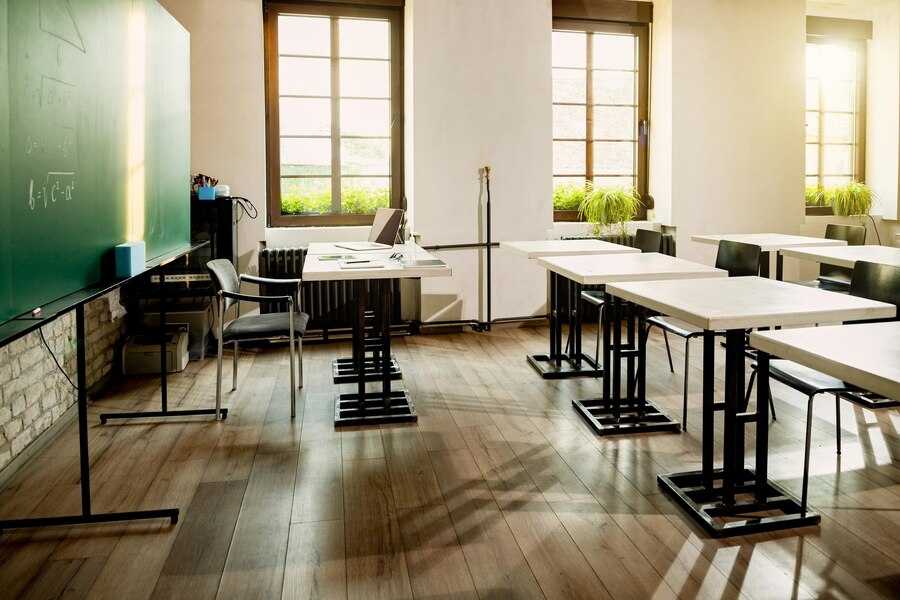Creating a learning environment that fosters academic success and personal growth is at the heart of every educator’s mission. However, one often overlooked element in achieving this goal is classroom design. This blog dives into the reasons why classroom design matters and how educators can harness its potential to enrich teaching and learning experiences.
The Impact of Classroom Design
Academic Performance and Engagement
Classroom design significantly influences students’ academic performance and engagement levels. According to a study by the University of Salford, well-designed classrooms can boost student learning progress by up to 16%. Simple changes like optimizing seating arrangements and ensuring good natural lighting can make a noticeable difference in how students interact with the material and each other.
Real-life examples underscore these findings. Schools that have invested in modern, flexible classroom designs often report higher student engagement and better test scores. For instance, a school in Finland revamped its classrooms to include movable furniture and group work zones, resulting in a marked improvement in student collaboration and participation.
Psychological and Physical Effects on Students and Educators
The design of a classroom also affects the psychological well-being of both students and educators. A cluttered, poorly lit space can lead to increased stress and decreased motivation. Conversely, a well-organized, aesthetically pleasing environment can enhance mood and reduce anxiety.
Research shows that physical comfort plays a crucial role in effective teaching and learning. Ergonomic seating and appropriate desk heights can prevent physical discomfort, allowing students and teachers to focus better on their tasks. For educators, a thoughtfully designed classroom can reduce the physical strain associated with long hours of teaching, thereby improving overall job satisfaction.
Key Elements of Effective Classroom Design
Flexible Seating Arrangements
Flexible seating arrangements are critical to creating a dynamic learning environment. By allowing students to choose their seating, educators can foster collaboration and comfort. Thus, durable student chairs are essential in this context. They withstand daily wear and tear while supporting a variety of activities, from group discussions to individual work. When students can move their chairs easily, they can engage more freely with their peers and their surroundings, resulting in increased interaction and participation.
Studies have shown that flexible seating can increase student participation and collaboration. With this in mind, consider incorporating various seating options like bean bags, standing desks, and modular furniture. This flexibility allows students to choose seating that best suits their learning style, promoting engagement and comfort. By breaking away from traditional seating, educators can create a more dynamic and inclusive learning environment. This approach caters to different learning preferences, making lessons more interactive and enjoyable.
Use of Natural Light and Color
Natural light is an essential yet often overlooked aspect of classroom design. Maximizing natural light can reduce eye strain and increase alertness. Ensure windows are unobstructed and consider using light-colored walls to reflect sunlight throughout the room.
Color also plays a significant role in influencing mood and concentration. Blue hues can promote calmness and focus, while yellow can stimulate creativity. By thoughtfully selecting colors, educators can create an environment conducive to different types of learning activities.
Integration of Technology
In today’s digital age, integrating technology into classroom design is imperative. Interactive whiteboards, tablets, and digital projectors can enhance the learning experience. Design your classroom to facilitate the seamless use of these technologies, ensuring that power outlets and charging stations are easily accessible.
Technology integration should also include digital collaboration tools. Platforms like Google Classroom and Microsoft Teams can be used alongside physical classroom design to create a hybrid learning environment. This approach prepares students for the future while making lessons more engaging and interactive.
Organization and Storage Solutions
A cluttered classroom can hinder learning, making organization a critical aspect of classroom design. Invest in storage solutions like shelves, bins, and lockers to keep materials organized and easily accessible. This not only creates a tidy learning environment but also teaches students the importance of organization.
Consider labeling storage areas to help students quickly find and return items. This practice fosters responsibility and independence, as students learn to manage their materials effectively. An organized classroom can significantly reduce distractions, allowing both students and teachers to focus better on learning activities.
Challenges and Solutions
Common Hurdles in Redesigning Classrooms
Redesigning a classroom can present several challenges, from budget constraints to resistance to change. Many schools operate on limited budgets, making it difficult to invest in expensive furniture or technology. Additionally, some educators and administrators may be hesitant to adopt new designs, preferring traditional setups.
Practical tips can help overcome these hurdles. Start small by rearranging existing furniture or adding a few flexible seating options. Gradually introduce changes to allow time for adjustment. Seek funding from grants or community donations to support larger projects.
Practical Tips for Educators
Educators looking to redesign their classrooms can benefit from a few practical tips. Engage students in the process by seeking their input on seating arrangements and color choices. This inclusion fosters a sense of ownership and excitement about the new design.
Consider the specific needs of your class. For example, younger students may benefit from more open space for movement, while older students might need individual workstations for concentration. Tailoring the design to your students’ needs ensures a functional and effective learning environment.
Future Trends in Classroom Design
Influence of Technology and Pedagogical Shifts
Technology continues to shape the future of classroom design. With the rise of hybrid learning, classrooms must adapt to accommodate both in-person and remote students. This trend requires flexible setups with easy access to digital tools and resources.
Pedagogical shifts also influence design trends. There is a growing focus on student-centered learning, where students take an active role in their education. Classrooms are evolving to support this approach, with more collaborative spaces and less reliance on traditional lecture-style setups.
Predictions for the Future of Educational Spaces
Looking ahead, educational spaces will likely become even more flexible and adaptable. Movable walls, modular furniture, and tech-integrated environments will become standard. These designs will support a variety of learning activities, from group projects to individual study sessions.
Sustainability will also play a significant role in future classroom design. Schools will increasingly use eco-friendly materials and energy-efficient technologies. This approach aligns with broader societal trends towards sustainability and environmental responsibility.
Thoughtful classroom design is more than just aesthetics; it’s a powerful tool for enhancing teaching and learning. By considering elements like flexible seating, natural light, and technology integration, educators can create environments that support academic success and personal growth.
Take a moment to reflect on your current classroom setup. Are there changes you could make to improve the learning experience for your students? We encourage you to explore new design ideas and share your experiences with fellow educators. Together, we can create inspiring spaces that nurture the next generation of learners.






